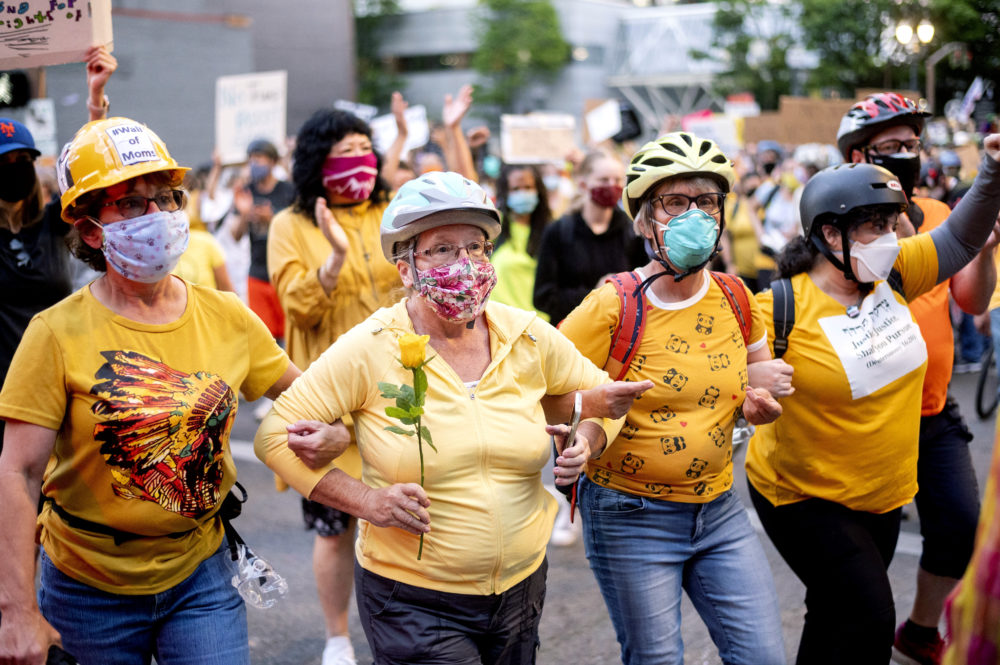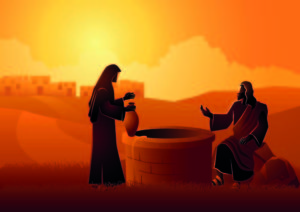My friend Amy and I spoke recently about the #Resistance movement, primarily as it has arisen during the Trump era. I’d written a blog, a tribute to civil rights and racial justice icon John Lewis. He was a master at nonviolent resistance, so much so that he spurred real change — like the enactment of the Voting Rights Act of 1965. Amy asked, “How did Jesus respond to injustice and violence?”
Me: Well, Jesus had several ways to challenge injustice, and many were direct and sometimes angry, especially where hypocrisy played a primary part in an unjust situation. But he never raised his hand to another person. On the contrary, he went to the cross without any physical resistance to the tortuous beatings.
Jesus had no patience for injustice or hypocrisy
In the parable of the Persistent Widow and the Unjust Judge, Jesus crafted a specific story about the need to confront injustice and hypocrisy. The judge represents this injustice and hypocritical attitude because he is uncaring and self-centered. Jesus also tells us to pray ceaselessly. So there was a spiritual component and a corresponding action necessary when demanding justice.
Amy: What about when an action devolves into violence?
Me: Do you mean like in Portland, Oregon, these days?
Amy: Well, yeah, like Portland.
I paused for a minute because last week I wrote a blog about how federal marshals had allegedly violated a photojournalist’s free press rights in Portland. She videotaped the ongoing street violence.
It’s been going on for over 60 days straight with no end in sight.
A Wall of Moms lead the peaceable assembly
After watching federal agents take people into custody using unidentified cars, one mom had an idea. To create a buffer between protesters and federal agents, Beverly “Bev” Barnum helped form the “Wall of Moms” to protect protesters.
After seeing the George Floyd murder and then watching as “police” grabbed protesters and whisked them away in unidentified cars, Barnum decided to do something. She made it clear that her group works closely with Black leaders, and “if they want one wall of moms, they get one. If they want two, they get two…if they tell us to jump, we jump, and if they tell us to leave, we leave.”
~We Shall Overcome~
The moms have learned songs from Black leaders; they don’t make up their own. They had to learn “We Shall Overcome” by singing it several times. Such a palpable air of respect exudes from these women. They walk alongside their Black brothers and sisters. They don’t try to takeover, as is so common when white people presume we have all of the answers.
Barnum noted that she wasn’t an activist until now, like many in the group. But she feels that women are preservers of life and human rights. “Mothers run to help when they see someone drowning or falling off a bike,” she says, “And the same idea applies to police violence against Black Americans.” When the moms arrive, protesters say, ‘Thank God the moms are here,’” she says.
What I love about the wall of moms is its simplicity — resistance in love, the preservation of life, and the speaking out against police brutality without violence towards the officers — it’s a preservation of their safety, too. That’s about having love for one another or, at least basic respect.
Dads wielding leaf-blowers
Likewise, Portland dads have followed suit and started a group called leaf-blower dads. When tear gas arises, the dads with their leaf-blowers at-the-ready appear and are raring to go. They blow the tear gas away from the protesters with these leaf-blowing machines. It’s a simple, somewhat lighthearted, and nonviolent way to dispel the dangerous fumes as well as the potential violence.
Jesus’ calls us to resist and persevere
Jesus taught us to resist, to be subversive even. He taught us to resist the temptation to retaliate. Here’s an example from the Gospel of Matthew in one of Jesus’s teaching passages:
38 “You have heard that it was said, ‘Eye for eye, and tooth for tooth.’ 39 But I tell you, do not resist an evil person. If anyone slaps you on the right cheek, turn to them the other cheek also. 40 And if anyone wants to sue you and take your shirt, hand over your coat as well. 41 If anyone forces you to go one mile, go with them two miles. . . 43 “You have heard that it was said, ‘Love your neighbor and hate your enemy.’ 44 But I tell you, love your enemies and pray for those who persecute you. (Mt. 5: 38-41, 43-44, NRSV)
The Gospel and the Old Testament have a common refrain — don’t retaliate
Jesus, as a devout Jew, knows the Old Testament. So when Jesus instructs us not to resist an evil-doer, he has some compelling biblical arguments. Jesus understood the idea of the talion, or lex talion, the “law of the claw.” We know it as “an eye for an eye.” The Torah specifically prohibited excessive force or violence, especially because retaliation can get out of hand quickly.
In verse 38, Jesus cleverly uses social convention to make his point. In those days, everyone had a “clean hand” and an “unclean hand.” The unclean hand was used for bathroom activities, if you know what I mean. So it was a major social insult to touch someone with your unclean hand, presumptively the left hand. And the custom was to hit with the back of the hand. So, the first slap would have been back-handed with the clean hand.
If someone slaps you, instead of hitting back, you turn your cheek the other way. By turning your head, you now force your assailant to hit you with a back-handed slap by the unclean hand. Now it has become awkward for the hitter. The initial insult will intensify if the hitter back-hands the other person’s cheek with the unclean hand. The hitter is starting to look like, and maybe even feel like, a fool or a scoundrel.
Next, let’s say a creditor sues you for your shirt. Jesus says we should not only hand over our shirt but also our cloak, the inner garment next to our skin. In Jesus’s time, social convention dictated that when you saw someone naked, you were shamed, not the naked person. As a result and in accordance with the common practice of his day, Jesus provided a means of resistance. By receiving the inner garment, the creditor now risks his own humiliation. He has pushed the debtor too far and literally exposed his humanity and his nakedness in the courtroom.
There is strength in weakness
By humbling ourselves and resisting the natural wish to defend ourselves, we succeed in shaming our opponents further.
In the time of Jesus, a Roman soldier could conscript someone to carry his pack for an entire mile. Carrying those heavy packs in withering heat exhausted the poor soul chosen for such duty. But instead of dropping that pack right at the 1 mile-marker, Jesus says to go one more mile. Such action created a real problem for the Roman soldier because Roman law prohibited his taking advantage of the civilian. Consequently, the conscripted person would have gotten the soldier into all sorts of trouble with his superior officer, regardless of whether the soldier ordered him to “go the extra mile.”
Finally, Jesus calls on us to pray for our enemies specifically. When we consciously choose not to retaliate we engage in a kind of prayer. We submit to God when we withhold our vengeance. There is a strength in our weakness. Of course, no one is a better example of that than Jesus.
Nonretaliation allows for powerful ways to break cycles of violence. We know that violence begets violence. So why not break that cycle in peaceful ways that may pave the way for reconciliation. Sometimes that seems implausible, but it does work over time. The responses that Jesus teaches seem counterintuitive. But they provoke reflection by the opponent, like, “Hey wait a minute, what is happening here? I thought I was in charge here.”
Burning down the house does not solve the root problems
Amy: I know you are very concerned from a constitutional standpoint about the conduct of the federal agents. But what do you think about violent protesters and burning down buildings?
Me: Well, I think this behavior is wrong. It violates the law of the claw–an eye for an eye. First, it is hazardous. Somebody could get trapped in a burning building. The protesters are claiming to have concern that Black Lives do Matter, so why risk killing someone by actions they commit in a fit of anger?
Second, I question what is motivating this behavior. It, too, causes chaos just as what the feds are doing. We don’t need chaos. We need dialogue, and a whole lot of it. We need to build up and not tear down.
Third, if we are talking about significant reform in policing, why burn down buildings that we need to accomplish that goal? As it stands, the taxpayers now have to foot the bill to replace a police precinct. Police reform does not mean eradicating public safety officers; we need well-trained, properly vetted safety officers. And, they need a building like any other business where community activities can occur in safety.
I reject the destruction of public buildings and businesses. It does not get to the root of the problem. As a native Detroiter, born and bred, I can attest to the fact that Detroit is still recovering from the 1967 Rebellion and the ensuing residential white flight and corporations leaving the city.
Necessary trouble, good trouble
Remember the sage advice from John Lewis about engaging in necessary trouble, good trouble. “We studied and were prepared for marches and the Freedom Rides. We developed strategies. And we were trained that when someone slaps you or pours hot coffee on you, and calls you every name except child of God, look them in the eye. You have to keep your cool.”
So for the leaf-blower-wielding dads dispelling the tear gas, and the wall of moms bravely walking the walk for social justice, let us follow their ingenious examples of strategic and effective nonviolent protests. Let us join such peaceful assemblies to lawfully petition our government, according to our First Amendment rights, to preserve life and not take life, and to preserve the Union.
In peace, let us pray, ~We shall overcome, I do believe. . .~
Norma Lewis holds a flower while forming a “wall of moms” during a Black Lives Matter protest on Monday, July 20, 2020, in Portland, Ore. (Noah Berger/AP)





